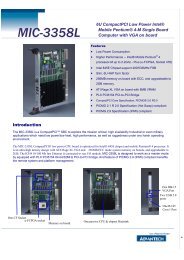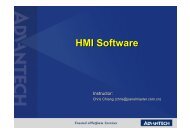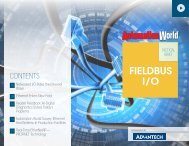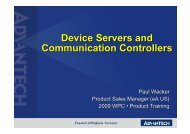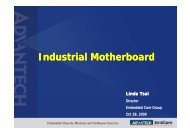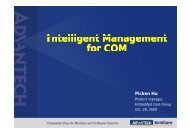industrial wireless book special edition - Networking ...
industrial wireless book special edition - Networking ...
industrial wireless book special edition - Networking ...
Create successful ePaper yourself
Turn your PDF publications into a flip-book with our unique Google optimized e-Paper software.
Infrastructure. By using routers as the infrastructure<br />
for clients that connect to them, the<br />
routers form a mesh of self-configuring, selfhealing<br />
links. With their inherent gateway<br />
functionality, mesh routers can also be<br />
connected to the Internet, thereby providing<br />
a backbone for traditional networks while<br />
enabling integration with existing <strong>wireless</strong><br />
networks.<br />
Hybrid. A combination of the previous two<br />
architectures, hybrid architecture performs the<br />
functions of infrastructure and client and, as such,<br />
can access the network through mesh routers as<br />
well as communicating with other mesh clients.<br />
This flexibility makes it the most suitable configuration<br />
for a majority of applications.<br />
In addition to these three designs, there are<br />
also three key feature classes that can be<br />
applied to each of them.<br />
Self-healing and Self-forming functions.<br />
Intelligent mesh capabilities with self-healing<br />
and route choosing algorithms (self-forming)<br />
determine their form by a calculation involving<br />
the number of hops and the radio signal quality<br />
for each hop. Each <strong>wireless</strong> connection in a<br />
mesh network will have a path score to<br />
represent the signal quality between nodes.<br />
The path score calculation includes RSSI<br />
(Received Signal Strength Indication), noise<br />
level and bandwidth flow information in<br />
providing the reference for calculation. The<br />
number of hops from source to destination is<br />
SISO SO<br />
usually a minor consideration in a routing<br />
algorithm.<br />
Multiple hopping functions. Intelligent<br />
<strong>wireless</strong> mesh systems may have a throughput<br />
of higher than 150Mbps at two hops and can<br />
still transfer data at 100Mbps after as many as<br />
10 hops. These sorts of throughput rate<br />
minimise concern about the carriage of high<br />
bandwidth deterministic traffic such as video<br />
and motion control data. Furthermore, the selfhealing<br />
function may reduce maintenance and<br />
other network management costs. A typical<br />
application might involve monitoring the status<br />
of remote oil fields; each derrick would use a<br />
node with self-healing and self-forming mesh<br />
capability (such as Advantech’s EKI-6351),<br />
transmitting data to an EKI-6340 AP node set<br />
up for direct backhaul to a control centre.<br />
Oil refineries provide an excellent example in<br />
MIMO MO<br />
the use use of self-healing, self forming and<br />
multi hopping algorithms. These sites have<br />
many separate areas that need to be continuously<br />
monitored and managed, but due to the<br />
nature of the business, fires are real possibility<br />
and may destroy the hardware monitoring a<br />
particular section. Once a link has been broken,<br />
routers up or downstream of damaged one<br />
might not be able to send their data back to<br />
the control centre with some conventional<br />
network configurations. Thanks to self-healing<br />
and forming and multiple hopping algorithms,<br />
the data can still get through.<br />
IEEE802.11n explained<br />
802.11n includes many enhancements to the<br />
earlier a/b/g versions of the protocol. These<br />
improvements include an increase in speed,<br />
range and reliability.<br />
<strong>industrial</strong> <strong>wireless</strong><br />
sponsored by Advantech<br />
<strong>industrial</strong> ethernet <strong>book</strong><br />
5



